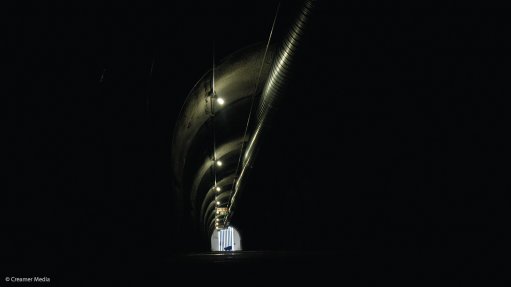
Tunnel at Wits Mining School's digital mine
Photo by: Duane Daws
JOHANNESBURG (miningweekly.com) – Research into South Africa’s 'mine of the future' needs to begin immediately, says University of the Witwatersrand (Wits) School of Mining Engineering head Fred Cawood.
The programme for the mine of the future needs to be broken into various phases, with the immediate goal being to mine more for less in order to provide cash flow for more intensive research.
The underground mining environment needs to be better understood and technology already widely used on surface, including satellite technology, needs to be migrated underground.
For that purpose, a digital mine mock-up is being established at the Wits School of Mining Engineering to assure safety and generate the cash for more profound longer-term research.
Cawood’s view is that mechanisation should follow optimisation and be accompanied by the introduction of a new mining layout.
But he sees the phase of optimisation, mechanisation and new layout as an interim measure that needs to be replaced over time by the entirely new mine design.
And that research, in his view, needs to begin right away.
In the last ten years, Wits has established the Centre for Sustainability in Mining, the Centre for Mechanised Mining Systems, the Wits Mining Research Institute (WMRI) and is busy establishing a digital mine beneath the School of Mining Engineering.
WMRI, kicked off by Minerals Minister Susan Shabangu 18 months ago, turned out to be bigger than the university expected, which has resulted in it stalling.
However, new vice-chancellor Professor Adam Habib committed to a decision on the institute in early 2014.
“We’re expecting a discussion at this week’s Senate meeting,” Cawood tells Mining Weekly Online in the attached video interview.
Pretoria University also has promising research initiatives under way and the State’s Council of Scientific and Industrial Research (CSIR) is conducting research, including laser research, which is expected to be adapted and used in underground mining.
JSE-listed Gold Fields, which provided the seed capital for Wits’ digital mine initiative, is also conducting research with the CSIR.
Gold major AngloGold Ashanti has introduced promising raise-boring technology, which leaps over mechanisation into automation and mines “all of the gold, only the gold, all the time, safely”.
“The AngloGold Ashanti initiative is looking very promising, where the mining method targets the meat in the sandwich. That is what we need to do,” says Cawood.
But sought, in addition, is an overarching new mining research body to resemble the now-disbanded Chamber of Mines Research Organisation (Comro).
“We haven’t found the Comro model yet and that’s what we need if we want to become world-class again,” Cawood says, adding that consolidation is needed to avoid too many well-intentioned initiatives falling short of the target.
“We need a common agenda. We need vision for all these initiatives so that all the initiatives deliver on that common goal, and the common goal is quite frankly a new mining method.
“Our biggest advantage is having access to this fantastic resource that strikes over hundreds of kilometres, that just keeps on going but it’s getting so deep now that’s becoming our disadvantage. We’re finding it more difficult to squeeze out profits without price or exchange rate windfalls to help us from time to time,” he adds.
From next year, Wits School of Mining Engineering expects to graduate 100 mining-engineering graduates a year, the overwhelming majority of them black students and more than a third of them female.